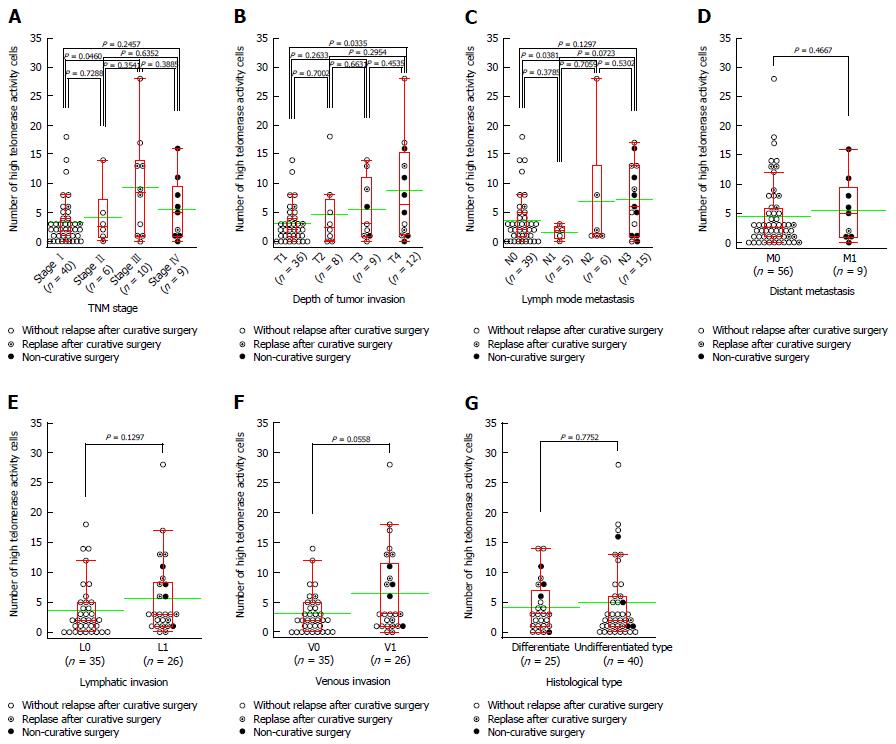Copyright
©The Author(s) 2016.
World J Gastroenterol. Dec 14, 2016; 22(46): 10232-10241
Published online Dec 14, 2016. doi: 10.3748/wjg.v22.i46.10232
Published online Dec 14, 2016. doi: 10.3748/wjg.v22.i46.10232
Figure 1 Comparison of green fluorescent protein fluorescence intensity and cell diameter.
A: Gallery of GFP-positive cell lines. The cell lines used were A549, HepG2, HEC-1, KATO-III, SBC-3, LNCaP, MDA-MB-468, and OVCAR-3; B: Comparison of GFP fluorescence intensity of cultured cell lines and blood cells from healthy volunteers and gastric cancer patients. The bottom and top of the box represent the lower and upper quartiles, and the band across the box shows the median. The lower and upper bars at the ends of the whiskers show the lowest data point and the highest data point, respectively. The cell lines used were A549, HepG2, HEC-1, KATO-III, SBC-3, LNCaP, MDA-MB-468 and OVCAR-3; C: Comparison of GFP fluorescence intensity between patients and healthy volunteers; D: Comparison of cell diameter between patients and healthy volunteers. To determine the cut-off line, we used ROC analysis to compare the GFP fluorescence intensity and diameter of cells from gastric cancer patients with those of healthy volunteers. Cells from the patients with gastric cancer had higher GFP intensities than those from the healthy volunteers (cut-off 78600927 MEFL sensitivity 82.5 %, specificity 39.7 %, and AUC 0.602). The diameters of GFP-positive cells in samples from patients with gastric cancer were higher than those in samples from healthy volunteers (cut-off 7.7418 μm, sensitivity 33.8 %, specificity 80.2 %, and AUC 0.578). GFP: Green fluorescent protein.
Figure 2 Relationship between circulating tumour cell number and pathological findings.
Dots indicate the numbers of CTCs in each patient blood sample. The bottom and top of the box represent the lower and upper quartiles, and the band across the box shows the median. The lower and upper bars at the ends of the whiskers show the lowest data point within 1.5 interquartile ranges of the lower quartile, and the highest data point within 1.5 interquartile ranges of the upper quartile, respectively. The green bar shows the average. A: Disease stage (Stages 1-4 indicate disease progression); B: Depth of tumour invasion (T1-T4 indicate increasing depth); C: Lymphatic metastasis (N0-3 indicate number of metastatic lymph nodes); D: Distant metastasis (M0 = negative, M1 = positive); E: Lymphatic invasion (L0 = negative, L1 = positive); F: Venous invasion (V0 = negative, V1-V2 = positive); G: Histological type (differentiated and undifferentiated types). A: Relationship between CTC number and disease stage; B: Relationship between CTC number and T category. The number of CTCs tended to increase with progression of primary tumour. There was a statistically significant difference in the number of CTCs between samples from patients with T1 and those from patients with T4 status (P = 0.0335); C: The relationship between CTC number and N category. There was a statistically significant difference in the number of CTCs between samples from patients with N0 and those from patients with N2 classification (P = 0.0381); D: Relationship between CTC number and M category. There was no significant difference in the number of CTCs between samples from patients with distant metastases and those from patients without distant metastasis (P = 0.4667); E: Relationship between CTC number and lymphatic invasion. The number of CTCs in samples from patients with lymphatic invasion was higher than that in patients without invasion. However, this result did not reach the level of significance (P = 0.1297); F: Relationship between CTC number and venous invasion. The number of CTCs in samples from patients with venous invasion was higher than that in samples from patients without this pathology. However, this result did reach the level of significance (P = 0.0558); G: Relationship between CTC number and histological type. There was no significant difference in the number of CTCs between samples from patients with differentiated tumours and those from patients with undifferentiated tumours (P = 0.7752). CTCs: Circulating tumour cells.
Figure 3 Overall and relapse-free survival.
A: The overall survival rate of 65 patients was compared using Cox proportional hazards analysis. Although there was no significant difference, the overall survival rate of the patients with more than 5 CTCs was lower than that of patients with 5 or less CTCs (hazard ratio, 2.07; 95%CI: 0.693-5.744; P = 0.183); B: The relapse-free survival rates of 57 patients with different CTC levels who underwent curative surgery were compared using Cox proportional hazards analysis. Relapse-free survival was significantly lower in patients with more than 5 CTCs (hazard ratio, 2.28; 95% CI: 0.068-4.698; P = 0.034). CTCs: Circulating tumour cells.
- Citation: Ito H, Sato J, Tsujino Y, Yamaguchi N, Kimura S, Gohda K, Murakami K, Onimaru M, Ohmori T, Ishikawa F, Inoue H. Long-term prognostic impact of circulating tumour cells in gastric cancer patients. World J Gastroenterol 2016; 22(46): 10232-10241
- URL: https://www.wjgnet.com/1007-9327/full/v22/i46/10232.htm
- DOI: https://dx.doi.org/10.3748/wjg.v22.i46.10232











